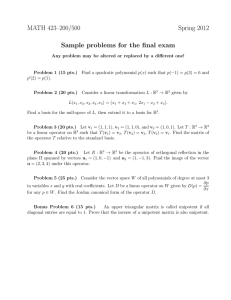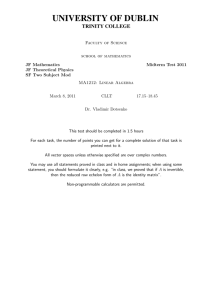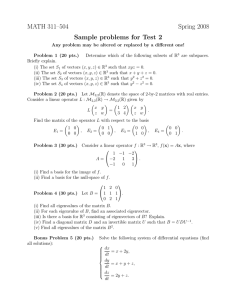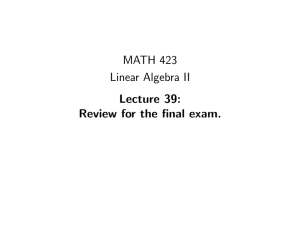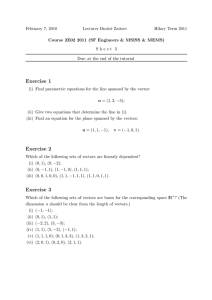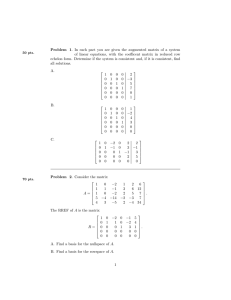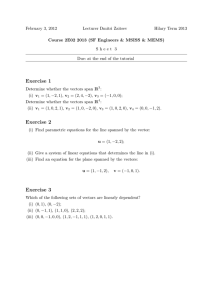MATH 423–200/500 Spring 2012 Sample problems for the final exam: Solutions
advertisement
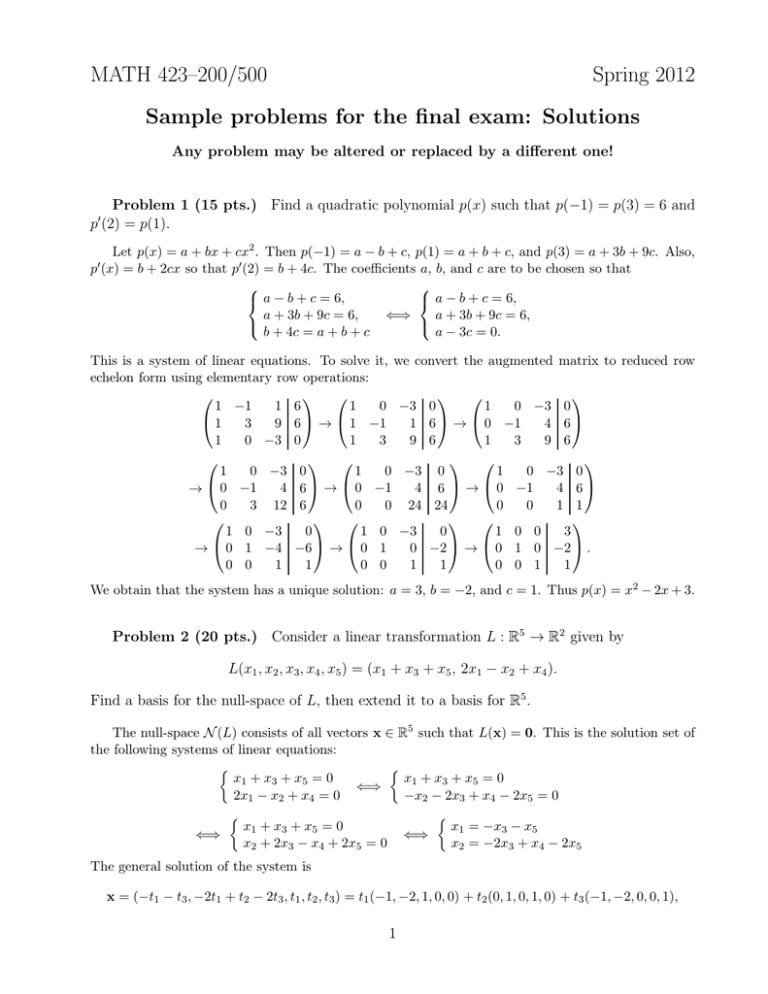
MATH 423–200/500 Spring 2012 Sample problems for the final exam: Solutions Any problem may be altered or replaced by a different one! Problem 1 (15 pts.) Find a quadratic polynomial p(x) such that p(−1) = p(3) = 6 and p (2) = p(1). ′ Let p(x) = a + bx + cx2 . Then p(−1) = a − b + c, p(1) = a + b + c, and p(3) = a + 3b + 9c. Also, = b + 2cx so that p′ (2) = b + 4c. The coefficients a, b, and c are to be chosen so that a − b + c = 6, a − b + c = 6, a + 3b + 9c = 6, ⇐⇒ a + 3b + 9c = 6, b + 4c = a + b + c a − 3c = 0. p′ (x) This is a system of linear equations. To solve it, we convert the augmented echelon form using elementary row operations: 1 0 −3 0 1 0 −3 1 −1 1 6 1 3 9 6 → 1 −1 1 6 → 0 −1 4 1 0 −3 0 1 3 9 6 1 3 9 1 → 0 0 1 → 0 0 1 0 −3 0 −1 4 6 → 0 3 12 6 0 1 0 −3 0 1 −4 −6 → 0 1 0 1 0 0 −3 0 1 −1 4 6 → 0 0 24 24 0 0 −3 1 0 1 0 −2 → 0 1 0 1 0 matrix to reduced row 0 6 6 0 −3 0 −1 4 6 0 1 1 0 0 3 1 0 −2 . 1 0 1 We obtain that the system has a unique solution: a = 3, b = −2, and c = 1. Thus p(x) = x2 − 2x + 3. Problem 2 (20 pts.) Consider a linear transformation L : R5 → R2 given by L(x1 , x2 , x3 , x4 , x5 ) = (x1 + x3 + x5 , 2x1 − x2 + x4 ). Find a basis for the null-space of L, then extend it to a basis for R5 . The null-space N (L) consists of all vectors x ∈ R5 such that L(x) = 0. This is the solution set of the following systems of linear equations: x1 + x3 + x5 = 0 x1 + x3 + x5 = 0 ⇐⇒ −x2 − 2x3 + x4 − 2x5 = 0 2x1 − x2 + x4 = 0 x1 + x3 + x5 = 0 x1 = −x3 − x5 ⇐⇒ ⇐⇒ x2 + 2x3 − x4 + 2x5 = 0 x2 = −2x3 + x4 − 2x5 The general solution of the system is x = (−t1 − t3 , −2t1 + t2 − 2t3 , t1 , t2 , t3 ) = t1 (−1, −2, 1, 0, 0) + t2 (0, 1, 0, 1, 0) + t3 (−1, −2, 0, 0, 1), 1 where t1 , t2 , t3 are arbitrary real numbers. We obtain that the null-space N (L) is spanned by vectors v1 = (−1, −2, 1, 0, 0), v2 = (0, 1, 0, 1, 0), and v3 = (−1, −2, 0, 0, 1). The last three coordinates of these vectors form the standard basis for R3 . It follows that the vectors v1 , v2 , v3 are linearly independent. Hence they form a basis for N (L). To extend the basis for N (L) to a basis for R5 , we need two more vectors. We can use two vectors from the standard basis. For example, the vectors v1 , v2 , v3 , e1 , e2 form a basis for R5 . To verify this, we show that a 5 × 5 matrix with these vectors as columns has a nonzero determinant: −1 0 −1 1 0 1 0 −1 0 −1 −2 1 −2 0 1 0 1 −2 1 −2 1 0 1 0 0 = 1. 0 0 0 = 0 0 0 1 0 1 0 0 0 0 0 0 0 0 0 0 0 0 1 1 0 0 Problem 3 (20 pts.) Let v1 = (1, 1, 1), v2 = (1, 1, 0), and v3 = (1, 0, 1). Let T : R3 → R3 be a linear operator on R3 such that T (v1 ) = v2 , T (v2 ) = v3 , T (v3 ) = v1 . Find the matrix of the operator T relative to the standard basis. Let U be a 3 × 3 matrix such that its columns 1 U = 1 1 are vectors v1 , v2 , v3 : 1 1 1 0. 0 1 To determine whether v1 , v2 , v3 is a basis for R3 , we find the determinant of U : 1 1 1 0 0 1 1 1 = −1. det U = 1 1 0 = 1 1 0 = 1 0 1 0 1 1 0 1 Since det U 6= 0, the vectors v1 , v2 , v3 are linearly independent. Therefore they form a basis for R3 . It follows that the operator T is defined well and uniquely. The matrix of the operator T relative to the basis v1 , v2 , v3 is 0 0 1 B = 1 0 0 . 0 1 0 Since the matrix U is the transition matrix from v1 , v2 , v3 to the standard basis, the matrix of T relative to the standard basis is A = U BU −1 . To find the inverse U −1 , we merge the matrix U with the identity matrix I into one 3 × 6 matrix and apply row reduction to convert the left half U of this matrix into I. Simultaneously, the right half I will be converted into U −1 : 1 1 1 1 0 0 1 1 1 1 1 1 1 0 0 1 0 0 (U |I) = 1 1 0 0 1 0 → 0 0 −1 −1 1 0 → 0 0 −1 −1 1 0 0 0 1 1 0 1 0 0 1 1 0 1 0 −1 0 −1 0 1 1 1 1 1 1 0 1 0 0 −1 1 1 1 0 0 0 1 0 → 0 −1 0 −1 0 1 → 0 −1 0 −1 0 1 → 0 −1 0 −1 0 1 0 0 −1 −1 1 0 0 0 −1 −1 1 0 0 0 −1 −1 1 0 2 1 1 1 0 0 −1 → 0 1 0 1 0 −1 = (I|U −1 ). 1 −1 0 0 0 1 Thus 1 1 A = U BU −1 = 1 1 1 0 1 1 1 −1 = 1 0 1 1 0 1 1 1 1 0 0 1 −1 1 1 0 1 0 0 1 0 −1 1 0 1 0 1 −1 0 1 1 1 0 0 0 −1 = 0 0 1 . −1 0 2 −1 −1 Problem 4 (20 pts.) Let R : R3 → R3 be the operator of orthogonal reflection in the plane Π spanned by vectors u1 = (1, 0, −1) and u2 = (1, −1, 3). Find the image of the vector u = (2, 3, 4) under this operator. By definition of the orthogonal reflection, R(x) = x for any vector x ∈ Π and R(y) = −y for any vector y orthogonal to the plane Π. The vector u is uniquely decomposed as u = p + o, where p ∈ Π and o ∈ Π⊥ . Then R(u) = R(p + o) = R(p) + R(o) = p − o. The component p is the orthogonal projection of the vector u onto the plane Π. We can compute it using the formula hu, v2 i hu, v1 i v1 + v2 , p= hv1 , v1 i hv2 , v2 i in which v1 , v2 is an arbitrary orthogonal basis for Π. To get such a basis, we apply the Gram-Schmidt process to the basis u1 , u2 : v1 = u1 = (1, 0, −1), −2 hu2 , v1 i v1 = (1, −1, 3) − (1, 0, −1) = (2, −1, 2). v2 = u2 − hv1 , v1 i 2 Now −2 9 (1, 0, −1) + (2, −1, 2) = (1, −1, 3). 2 9 Then o = u − p = (1, 4, 1). Finally, R(u) = p − o = (0, −5, 2). p= Problem 5 (25 pts.) Consider the vector space W of all polynomials of degree at most 3 ∂p in variables x and y with real coefficients. Let D be a linear operator on W given by D(p) = ∂x for any p ∈ W . Find the Jordan canonical form of the operator D. The vector space W is 10-dimensional. It has a basis of monomials: 1, x, y, x2 , xy, y 2 , x3 , x2 y, xy 2 , y 3 . Note that D(xm y k ) = mxm−1 y k if m > 0 and D(xm y k ) = 0 otherwise. It follows that the operator 4 D maps each monomial to zero, which implies that this operator is identically zero. As a consequence, 0 is the only eigenvalue of the operator D. To determine the Jordan canonical form of D, we need to determine the null-spaces of its iterations. Indeed, dim N (D) is the total number of Jordan blocks in the Jordan canonical form of D. Next, dim N (D 2 ) − dim N (D) is the number of Jordan blocks of dimensions at least 2 × 2. Further, dim N (D 3 ) − dim N (D 2 ) is the number of Jordan blocks of dimensions at least 3 × 3, and so on. . . 3 The null-space N (D) is 4-dimensional, it is spanned by 1, y, y 2 , y 3 . The null-space N (D 2 ) is 7-dimensional, it is spanned by 1, y, y 2 , y 3 , x, xy, xy 2 . The null-space N (D 3 ) is 9-dimensional, it is spanned by 1, y, y 2 , y 3 , x, xy, xy 2 , x2 , x2 y. The null-space N (D 4 ) is the entire 10-dimensional space W . It follows that the Jordan canonical form of D contains one Jordan block of dimensions 1 × 1, 2 × 2, 3 × 3, and 4 × 4: 0 0 0 0 0 0 0 0 0 0 0 0 1 0 0 0 0 0 0 0 0 0 0 0 0 0 0 0 0 0 0 0 0 0 1 0 0 0 0 0 0 0 0 0 0 1 0 0 0 0 0 0 0 0 0 0 0 0 0 0. 0 0 0 0 0 0 0 1 0 0 0 0 0 0 0 0 0 0 1 0 0 0 0 0 0 0 0 0 0 1 0 0 0 0 0 0 0 0 0 0 Bonus Problem 6 (15 pts.) An upper triangular matrix is called unipotent if all diagonal entries are equal to 1. Prove that the inverse of a unipotent matrix is also unipotent. Let U denote the class of elementary row operations that add a scalar multiple of row #i to row #j, where i and j satisfy j < i. It is easy to see that such an operation transforms a unipotent matrix into another unipotent matrix. It remains to observe that any unipotent matrix A (which is in row echelon form) can be converted into the identity matrix I (which is its reduced row echelon form) by applying only operations from the class U . Now the same sequence of elementary row operations converts I into the inverse matrix A−1 . Since the identity matrix is unipotent, so is A−1 . 4
